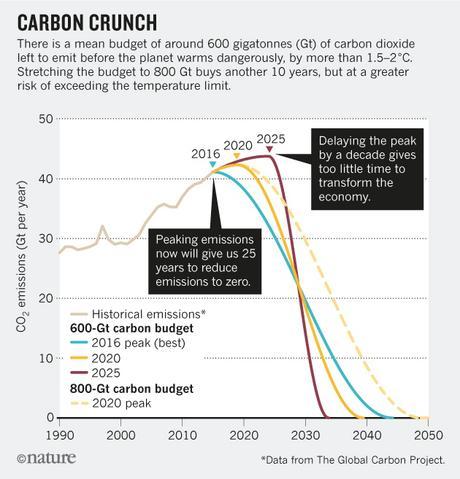GR: An article published yesterday (June 28, 2017) in Nature presents stern warnings from leading climate scientists. A list of necessary actions accompanies the warnings. The warnings come at a time when the majority of citizens in countries that use the most fossil fuel believe that global warming is a real threat. Is the majority strong enough? Can they convince their leaders to turn away from the riches offered by the leading polluters. Can they do it in three years?
The article below addresses with fossil-fuel emissions. I have to step aside for a moment and point out that there are many other threats. First, climate change is accelerating and may already be out of control. Recent research in the Arctic indicates that methane might have begun an exponential increase that we can’t stop.
Second, the food and water requirements of the human population are already exceeding Earth’s productive capacity. Population displacements and conflicts have begun and can only grow worse.
Third, Earth’s ecosystems are failing due to human impacts. People are cutting and burning the forests, farms are exhausting the soils, and wildlife is disappearing.
However, if people can indeed make the needed changes in fossil fuel use in three years, perhaps they will then go on to tackle the other great problems. Yay people!
“Christiana Figueres and colleagues set out a six-point plan for turning the tide of the world’s carbon dioxide by 2020.

Decarbonizing the world economy will require renewable energy generation from vast solar farms, such as this one in Nevada.
“In the past three years, global emissions of carbon dioxide from the burning of fossil fuels have levelled after rising for decades. This is a sign that policies and investments in climate mitigation are starting to pay off. The United States, China and other nations are replacing coal with natural gas and boosting renewable energy sources. There is almost unanimous international agreement that the risks of abandoning the planet to climate change are too great to ignore.Related stories
“The technology-driven transition to low-carbon energy is well under way, a trend that made the 2015 Paris climate agreement possible. But there is still a long way to go to decarbonize the world economy. The political winds are blustery. President Donald Trump has announced that the United States will withdraw from the Paris agreement when it is legally able to do so, in November 2020.
“The year 2020 is crucially important for another reason, one that has more to do with physics than politics. When it comes to climate, timing is everything. According to an April report(1) (prepared by Carbon Tracker in London, the Climate Action Tracker consortium, the Potsdam Institute for Climate Impact Research in Germany and Yale University in New Haven, Connecticut), should emissions continue to rise beyond 2020, or even remain level, the temperature goals set in Paris become almost unattainable. The UN Sustainable Development Goals that were agreed in 2015 would also be at grave risk.
“That’s why we launched Mission 2020 — a collaborative campaign to raise ambition and action across key sectors to bend the greenhouse-gas emissions curve downwards by 2020 (www.mission2020.global).
“As 20 leaders of the world’s largest economies gather on 7–8 July at the G20 summit in Hamburg, Germany, we call on them to highlight the importance of the 2020 climate turning point for greenhouse-gas emissions, and to demonstrate what they and others are doing to meet this challenge. Lowering emissions globally is a monumental task, but research tells us that it is necessary, desirable and achievable.
“After roughly 1°C of global warming driven by human activity, ice sheets in Greenland and Antarctica are already losing mass at an increasing rate. Summer sea ice is disappearing in the Arctic and coral reefs are dying from heat stress — entire ecosystems are starting to collapse. The social impacts of climate change from intensified heatwaves, droughts and sea-level rise are inexorable and affect the poorest and weakest first.
“The magnitude of the challenge can be grasped by computing a budget for CO2 emissions — the maximum amount of the gas that can be released before the temperature limit is breached. After subtracting past emissions, humanity is left with a ‘carbon credit’ of between 150 and 1,050 gigatonnes (Gt; one Gt is 1 × 109 tonnes) of CO2 to meet the Paris target of 1.5 °C or well below 2 °C (see go.nature.com/2rytztf). The wide range reflects different ways of calculating the budgets using the most recent figures.
“At the current emission rate of 41 Gt of CO2 per year, the lower limit of this range would be crossed in 4 years, and the midpoint of 600 Gt of CO2 would be passed in 15 years. If the current rate of annual emissions stays at this level, we would have to drop them almost immediately to zero once we exhaust the budget. Such a ‘jump to distress’ is in no one’s interest. A more gradual descent would allow the global economy time to adapt smoothly.
“The good news is that it is still possible to meet the Paris temperature goals if emissions begin to fall by 2020 (see ‘Carbon crunch’).

Sources: Stefan Rahmstorf/Global Carbon Project; http://go.nature.com/2RCPCRU
Sources: Stefan Rahmstorf/Global Carbon Project; http://go.nature.com/2RCPCRU
“Greenhouse-gas emissions are already decoupling from production and consumption. For the past three years, worldwide CO2 emissions from fossil fuels have stayed flat, while the global economy and the gross domestic product (GDP) of major developed and developing nations have grown by at least 3.1% per year (see go.nature.com/2rthjje). This is only the fourth occasion in the past 40 years on which emission levels have stagnated or fallen. The previous three instances — in the early 1980s, 1992 and 2009 — were associated with global economic predicaments, but the current one is not(2).” —Christiana Figueres, Hans Joachim Schellnhuber, Gail Whiteman, Johan Rockström, Anthony Hobley , & Stefan Rahmstorf (Source: Three years to safeguard our climate : Nature News & Comment)

